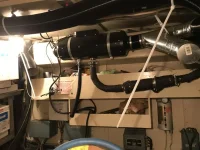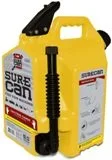oscarvan
Legendary Member
- Joined
- Oct 31, 2015
- Messages
- 2,926
- Status
- OTHER
- Hatteras Model
- Not Currently A Hatteras Owner
Just some musings I want to throw at the mind boggling brain power here....... Not saying I would do any or all of this, just kicking things around.
The reverse cycle machines work very well, as long as the water is not cold and there's heat to extract. This means Fall season is covered as, in my case the Bay is still above 60ºF.
Spring and, of course, winter are a different story.
One could add electric heat sources from space heaters plugged into outlets to built in electric floor heat to base boards.....
One could install diesel forced hot air heaters, of the Eberschprächer/Webasto variety...Fuel supply, ducting, air supply/exhaust. Number and location TBD
One could install and Aquahot style hydronic system with a boiler, water supply and return lines, heat exchangers with fans or, again, floor heat.
But I had the following idea..... All the distribution is already there in the reverse cycle machines, the only reason they peter out is because the water gets cold. So how about I give it warmer water? Redirect the cooling pump flow from/to either a tank or on demand heater. Fill it all with glycol and it would be frost proof. When the water warms up again flip the valves and go back to overboard....... Could be electric, which would be somewhat limited, or diesel fired which could be quite effective.....
This guy puts out 15KW of energy which, in theory, would heat 2000 square foot...
https://www.heatso.com/webasto-12-volts-water-heaters/
Thoughts?
The reverse cycle machines work very well, as long as the water is not cold and there's heat to extract. This means Fall season is covered as, in my case the Bay is still above 60ºF.
Spring and, of course, winter are a different story.
One could add electric heat sources from space heaters plugged into outlets to built in electric floor heat to base boards.....
One could install diesel forced hot air heaters, of the Eberschprächer/Webasto variety...Fuel supply, ducting, air supply/exhaust. Number and location TBD
One could install and Aquahot style hydronic system with a boiler, water supply and return lines, heat exchangers with fans or, again, floor heat.
But I had the following idea..... All the distribution is already there in the reverse cycle machines, the only reason they peter out is because the water gets cold. So how about I give it warmer water? Redirect the cooling pump flow from/to either a tank or on demand heater. Fill it all with glycol and it would be frost proof. When the water warms up again flip the valves and go back to overboard....... Could be electric, which would be somewhat limited, or diesel fired which could be quite effective.....
This guy puts out 15KW of energy which, in theory, would heat 2000 square foot...
https://www.heatso.com/webasto-12-volts-water-heaters/
Thoughts?



